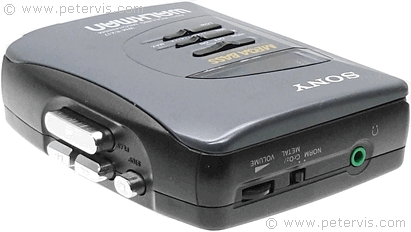Sony WM-EX17

The WM-EX17, also known as "WM-EX 17", is a stereo cassette player Walkman manufactured by the Sony Corporation in approximately 1990, and assembled in Malaysia. It comes with Fontopia type headphones and Mega Bass expansion circuitry. It is identical to the previous model WM-EX16, with minor differences in the supplied headphones. The WM-EX16 came with MDR-14A headphones, whilst the WM-EX17 came with the MDR-E551V headphones for UK customers. The latter model also had cushioning under the motor, for shock absorption. During the 90s, Sony also made the WM-EX14 and WM-EX18 versions, which had Dolby noise reduction circuitry, and were identical to the WM-EX17 in every other respect.


This is a basic looking model with a grey plastic case, and to non-professionals, it would appear as an average basic player, however all of the innovations are in the electronics, and the manufacturing processes. The elimination of metal screws and components was a clear drive towards making a greener product. In this design, they eliminate the transport mechanism chassis, which traditionally would have been metal, and instead mount the cogwheels onto the printed circuit board. Consequently, this unit is extremely light and comfortable to carry around on a long journey.



This cassette player provides 8 hours of operation time with a pair of "AA" size dry cells, because of advancements in semiconductor technology making the chipset more efficient with reduced power consumption. This walkman uses the LA4571 audio integrated circuit (IC) manufactured by the Sanyo Corporation of Japan. They made a leap forward by making a low-voltage IC that could operate on 3 V. The quiescent supply current for this IC is typically 17 mA, resulting in greater operation time. In addition, this IC does not require any input or output coupling capacitors. Usually a capacitor is required for the output; however, in this case, the output pins 11, 12, and 13 connect directly to a headphone set. This development not only improved the sound but also reduced the component count.

I also thought that the tape speed was smooth, which made it more enjoyable to listen. This unit has a DC motor (M901) controlled by an elaborate servo control IC MM1038F. Depending upon the production batch, the motor can be either from the Matsushita Corporation, or from Sankyo Corporation. Interestingly, there is no weighty capstan flywheel, and instead a large plastic pulley takes its place.

Review

It is what it is. This is a decent player, which provides a nice sound reminiscent of the 90s. It is not high-end, but something usable and enjoyable for everyday use by everyone. It has some basic useful functions, making it simple for everyone to use. It has a slider control to allow you to set the precise amount of bass in your music, which is very useful. There is also a switch to set the correct bias for metal / chrome and normal tapes.
I did not test this with the original headphones, as I did not have them; however, with a pair of MDR-W15 headphones, the sound was decent.

Cost / eBay

These early units from the 90s are starting to become rare because people usually discarded them once they bought the next gadget. A plain grey / black ergonomic design in plastic did not make it look high-end and consequently people were quick to throw them away.
The price very much depends upon its operational status, and cosmetic condition. However, most importantly, whether any collectors on the day understand what they see.
This Article Continues...
Sony WM-EX17Sony WM-EX17 Removing Back Cover
Sony WM-EX17 inside View
Sony WM-EX17 Audio IC
Sony WM-EX17 Drive Belt
Sony WM-EX17 Motor and Servo IC
Sony WM-EX17 Head and Pinch Roller
Sony WM-EX17 Power Supply
Sony WM-EX17 Box and Manual
